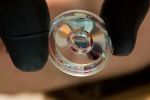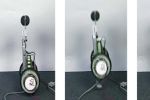Don't like your neighbors? Just stroll away
Houses are normally fairly stationary objects, and that's not considered a bad thing. But innovation never stands still, and a new prototype house that can walk on six legs has been built . The house is ten feet high, powered by solar panels, and is outfitted with a kitchen, toilet, bed, and wood stove. Last week, the house, a collaboration between MIT and the Danish design collective N55, took a journey through Cambridgeshire in England as part of an art project at the Wysing Art Center. Designed to move at the muscle speed of a human, the house walked at about five kilometers an hour around the 11-acre campus. (See video)
[
Read Full Story ]









